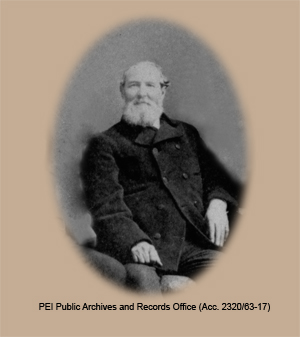

|
|
|||
|
|
|||
|
|
Thomas Charles Alley (1820-1900)

Thomas Charles Alley's father (also known as Thomas Charles) immigrated to Prince Edward Island from Dublin, Ireland in 1818. When the future architect was born on August 12, 1820, the Island's capital city had few public buildings of any architectural consequence, except perhaps, the Island's first legislature and courthouse on Queen Square. It had been designed in 1810 by John Plaw (1745-1820). Plaw had just died three months earlier. In the architectural history of the province, one door had closed while another had just opened.
Like John Plaw, Thomas Alley would also design a courthouse on Queen Square, as well as a church. Plaw, before he immigrated to the Island in 1807, designed London's St. Mary's Anglican Church on Paddington Green (1788-1791). As a Methodist, one of Alley's first designs was Charlottetown's First Methodist (now Trinity United Church), completed in 1863. Both churches are still standing, albeit on either side of the Atlantic. Plaw's style was influenced by the Neo-classical or Georgian. Alley's church shows Gothic elements, while his later public buildings are influenced by the Italianate style.
Plaw's combined courthouse and legislature was a fixture on Queen Square until Isaac Smith's new Colonial Building (now known as Province House) was opened in 1847. It also contained both a legislature and courthouse. However, following the Island's union with the Dominion of Canada in 1873, the Colonial Building was too cramped and a new edifice was needed to house judicial proceedings. Thomas Alley was selected as the architect for the new Law Courts building which was completed from 1874-1876.

His success in winning the commission for the new Law Courts was likely aided by the example of his Union Bank Building, which had been completed earlier in 1872 and remains a prominent structure on Queen Square. The style of both buildings is Italianate with round headed windows, quoins of Wallace stone, and mansard roofs.
All of Alley's public buildings were constructed of brick. This is not surprising considering he served as Fire Chief for the City of Charlottetown from 1864-1875 and witnessed the Great Fire of 1866 which destroyed four city blocks! The trauma of this event would have convinced him of the benefits of brick. Alley was also serving at this time in the Island government as Superintendent of Public Works.
His own residence at 62 Prince Street, where he raised his family with his wife, Anne MacKay, was completed contemporaneous to the construction of the new Law Courts and shows a similar Italianate style with round headed windows, a mansard roof with dormers, quoins, and a corbelled cornice near the eave. Naturally, it was also built of brick.
It seems appropriate that Alley's son, George Alley (1844-1899) who predeceased him, would become one of the youngest judges in the country when he was appointed county court judge for Queens County in 1874.
Today all four of Alley's buildings remain as landmarks in Charlottetown, while none of John Plaw's work in PEI has survived. Thomas Alley passed away on March 17, 1900 and rests in Charlottetown's Sherwood Cemetery.


|

|

